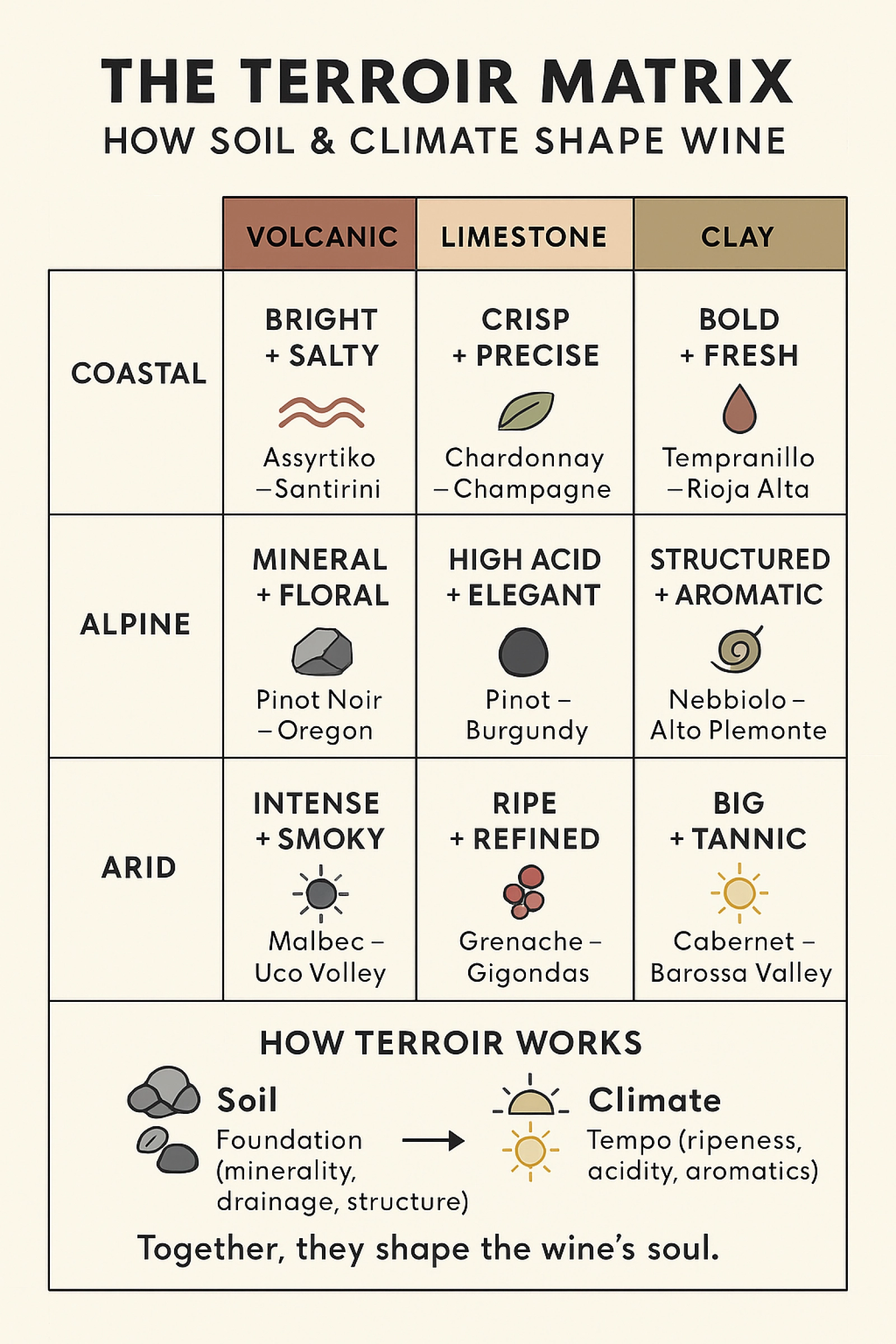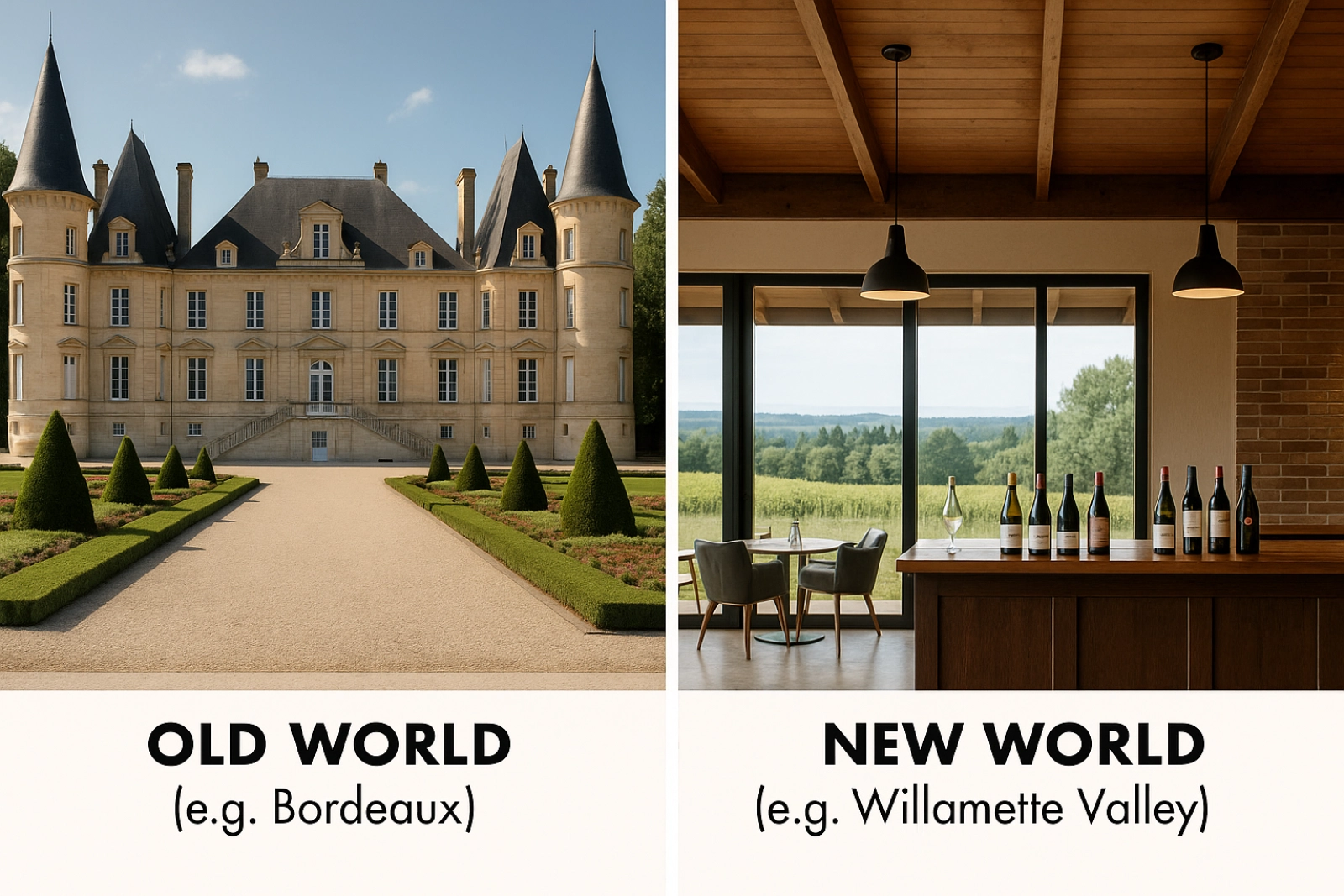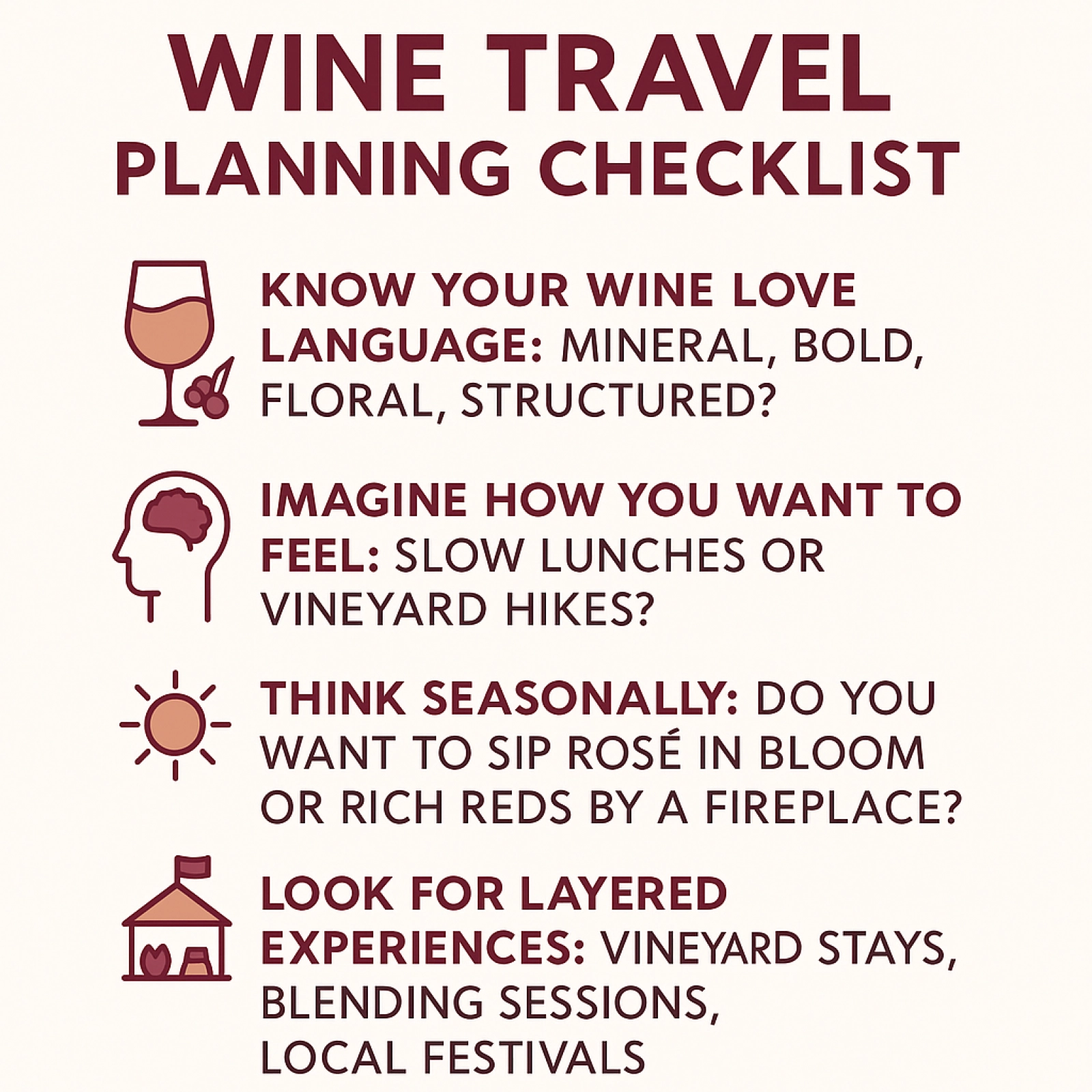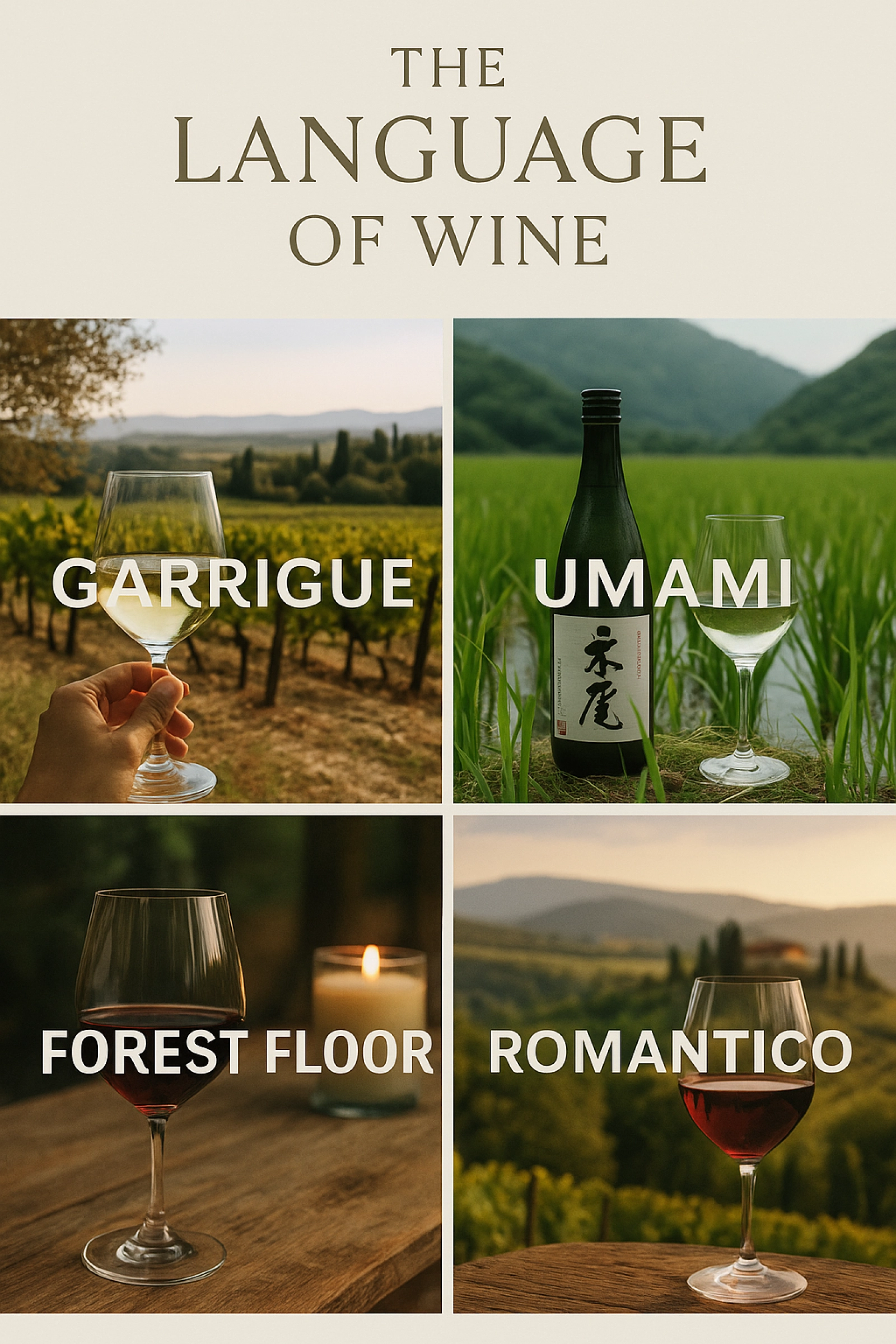Uncorking the Essence: Discovering Unique Wine Countries and Selecting Your Perfect Destination
Wine travel is about more than just tasting - it’s about discovering the places, cultures, and people behind each sip.
From centuries-old European cellars to emerging vineyards on volcanic islands, the world of wine is vast and vibrant. But with so many terroirs, styles, and experiences to explore, many travelers wonder how to choose a wine region to visit — one that truly speaks to their senses and soul.
At Into The Vineyard, we believe wine travel should be deeply personal - guided by your palate, pace, and passion. Whether you’re a seasoned sipper or just starting your journey, this guide uncorks the essence of wine tourism: from the soil beneath the vines to the sensory joys of each season.
Table of Contents
- The Terroir Tapestry: Decoding Wine Country DNA
- Beyond Borders: The New World vs. Old World Wine Paradigm
- The Sensory Sommelier: Choosing Your Perfect Wine Destination
- The Unsung Terroirs: Hidden Gems in the Wine World
- The Rhythms of the Vine: Seasonal Symphonies in Wine Regions
- Liquid Linguistics: The Language of Wine Across Cultures
- The Digital Vine: Technology's Role in Modern Wine Tourism
The Terroir Tapestry: Decoding Wine Country DNA
What gives a wine country its soul? It’s more than postcard-perfect vineyards or centuries-old cellars. At its core lies terroir - a poetic blend of soil, climate, elevation, and human touch that you can taste in every glass.
.
Geological Whispers
The ground beneath your feet is a story millions of years in the making. In Chablis, ancient Kimmeridgian limestone - dense with fossilized sea life - gives its Chardonnay that unmistakable crisp edge and flinty elegance. You’re not just sipping a white wine; you’re tasting a seabed frozen in time.
For travelers drawn to purity and precision, regions like Chablis offer a striking clarity, a place where geology becomes glass.
For a deeper dive into the historical aspects of wine regions, check out our article on elusive travel experiences in France, which explores some of the oldest wine cellars in the world.
Tectonic Tastings
Elevation and ancient earth movements create flavor diversity that even neighboring vines can't replicate. Take Mendoza: many vineyards here soar over 1,000 meters high. The result? Malbecs with lush fruit, vibrant acidity, and that signature freshness you can’t quite forget.
Prefer your reds bold but refined, wrapped in mountain air and dramatic landscapes? Mendoza might be your match.
Interestingly, even wine glass design is evolving to better reflect terroir. As Food & Wine recently reported, producers are creating glass shapes tailored to highlight the textures and aromas of wines grown in different soils, from volcanic to chalky

Climate’s Liquid Poetry
If soil is a wine’s backbone, climate is its heartbeat. Picture fog drifting over Sonoma’s Russian River Valley or sun-baked hillsides in Sicily. These environmental rhythms shape a region’s wines and your experience as a traveler.
In Argentina’s Uco Valley, dramatic day-night temperature swings coax grapes into perfect balance, resulting in wines that feel both structured and expressive.
But it’s not just about viticulture; it’s about how it feels to stand there. The dry heat, the whisper of wind through the vines, the scent of crushed herbs - terroir is a sensory symphony waiting to be explored.
Whether you’re drawn to the volcanic tension of Etna, the mineral hush of Chablis, or the high-altitude elegance of Mendoza, decoding terroir isn't just about science, it's the first step in finding a destination that resonates with your senses.
Beyond Borders: The New World vs. Old World Wine Paradigm

For decades, wine lovers were taught to choose: tradition or innovation, appellation or attitude - the Old World or the New. But today’s landscape is more fluid, more fascinating, and more tailored to the modern traveller. The lines are blurring, and that’s exactly where the magic lies.
Tradition in Transition
The Old World still whispers stories through its cellars, but many of its regions are evolving. In Bordeaux, winemakers are trialling heat-resilient grapes like Touriga Nacional to meet a warming climate. In Burgundy, some domaines are experimenting with amphora aging, reinterpreting ancient methods for today’s tastes.
This isn’t about abandoning history. It’s about preserving elegance while adapting with grace.
If you long for an experience where heritage is alive, not museum-like, places like Bordeaux or Burgundy offer intimate tastings in historic châteaux, where each bottle bridges past and present.
Tech Meets Terroir
One of the most exciting developments is the rise of tech in traditional regions. Vineyards in Champagne and Burgundy now use drones to assess vine health. Across in the Douro Valley, GPS-driven harvest planning helps optimize sugar levels by plot.
It’s about preserving quality in a changing world. And in places like Bordeaux, where the changing climate has brought earlier harvests and unpredictable weather, these tools are fast becoming essential.
Lonely Planet reported on how French wine regions are embracing sustainability and innovation for more on how the Old World is leaning into new tools.
For the traveler who sees beauty in precision, or who finds wonder in the harmony of tradition and technology, these are the regions where innovation doesn’t replace romance — it refines it.
New World Renaissance
Meanwhile, New World regions are shedding their “upstart” status and embracing what makes them unique. In Oregon’s Willamette Valley, for example, you’ll find winemakers working with restraint and reverence, producing Pinots that rival Burgundy, but with a distinctly Pacific Northwest soul.
In South Africa’s Elgin or New Zealand’s Central Otago, you can taste the tension between rugged landscapes and refined technique. Don’t assume these are copycats of the Old World - they’re crafting their own identities, rooted in climate, culture, and confidence.
Looking for wild beauty paired with polished hospitality? The New World delivers big landscapes, bold ideas, and some of the most memorable private tastings you’ll ever experience.
Indigenous Innovation
One of the most exciting evolutions? The return to indigenous grape varieties. Portugal is a leader here, with more than 250 native grapes, many of which thrive in today’s climate and yield character-rich wines with deep cultural roots.
In Argentina, alongside high-altitude Malbec, you’ll find revivals of Torrontés: floral, crisp, and perfect for sun-drenched afternoons in the Andes.
These grapes tell stories that global varietals can’t. And when you taste them in their birthplace, with local dishes and warm-hearted hospitality, the experience becomes unforgettable.
Whether you’re drawn to centuries-old cellars or cutting-edge sustainability, your perfect wine destination might be where tradition and innovation meet - and where every glass tells both an old tale and a new beginning.
The Sensory Sommelier: Choosing Your Perfect Wine Destination
Forget maps and must-visits. If you're wondering how to choose a wine region to visit, start not with a country — but with a feeling. A texture. A scent. A craving. The way a wine lingers, the way it whispers of its origin.
So how do you choose where to go next? Start not with a pin on the map, but with your palate and let your senses lead the way.
Palate as Passport
Are you drawn to the electric zing of citrusy whites? To reds that feel like velvet and spice? Or to earthy, age-worthy bottles that open slowly, like a good story?
If you find yourself sipping lean, mineral-driven Chardonnays, you may be craving the cool tension of Chablis or the salt-kissed breezes of Galicia. If you gravitate toward wild, herbaceous Syrah, consider the windswept hills of the Northern Rhône or South Africa’s Swartland where the wines reflect the rugged terrain.
Our travelers often begin here: identifying what they feel in the glass then discovering the place that matches that feeling.

Flavor Cartography
Once your palate points the compass, the possibilities unfold.
Dreaming of rosés that taste like summer fields? Provence in June is calling. Obsessed with structured Nebbiolo that smells like roses and truffles? A misty autumn in Barolo will feel like poetry.
Each sip becomes a memory in waiting.
Prefer to keep it coastal? Think Ligurian Vermentino with grilled seafood, or Albariño by the Galician shore. Want something alpine and pure? Pinot Noirs in Oregon or Germany’s Pfalz offer forest-floor elegance and a kiss of mountain air.
Aroma Adventures
Some regions smell as good as they taste. In Alsace, the air is sweet with orchard blossoms and spiced pastries, echoing the aromatic Gewürztraminers and Rieslings poured in timber-framed tasting rooms.
In Santorini, volcanic-grown Assyrtiko carries the island’s raw intensity, saline, sunlit, unforgettable. The wine is mineral, yes, but also emotional: it tastes like standing on a caldera, sea breeze in your hair, history underfoot.
Experience Alchemy
The real magic of wine travel happens when your senses, surroundings, and soul align.
You might start your day with a market tour in Sicily, take a cooking class beside a vineyard, then sip Nero d’Avola while watching the sun melt into olive groves. Or hike the Camino coastline, then toast your effort with a chilled glass of Albariño beside a cliffside seafood shack.
If you're wondering how to create a travel experience that blends tastings, culture, and local exploration, our guide How to Plan a Trip to Wine Country That Balances Tastings, Culture & Exploration walks you through how to do just that.
Luxury is about presence: the right pace, the right pour, the right place.
For tips on planning your wine country experience, check out our guide on why planning ahead for your wine tour is essential.
The Unsung Terroirs: Hidden Gems in the Wine World
Everyone knows Bordeaux, Napa, and Tuscany. But some of the most exciting wine stories are unfolding in places you’ve maybe never heard of or considered. These hidden gem regions might not yet be household names, but they’re producing expressive, terroir-driven wines with serious personality - and often, fewer crowds.
And with wine tourism growing by 18% annually since 2016, savvy travellers are starting to look beyond the usual suspects to find something a little more… grounded.
According to Wine Institute, 79% of wine tourists say a region’s unique characteristics are the primary reason they choose it.
For more insights into emerging wine regions, explore our article on under-the-radar wine destinations that are making waves in the industry.

Rising Stars of Viticulture
Let’s start with the up-and-comers. In Georgia, winemaking is an 8,000-year-old tradition - and it still happens in clay qvevri buried beneath the earth. Visit the Kakheti region and you might find yourself in a candlelit tasting room, sipping amber wine with the family who made it.
In Slovenia’s Brda hills, boutique producers craft skin-contact whites that dance between old-world elegance and natural-wine edge - poured in ivy-covered farmhouses with views stretching to the Adriatic.
Uruguay’s coastal vineyards are redefining red wine with Tannat: dense, smoky, and sea-breezed. And in Japan’s Yamanashi, Koshu offers a delicate, citrus-laced profile that pairs perfectly with sashimi, a truly local experience, especially when enjoyed at a mountain-top ryokan.
Climate Pioneers & New Frontiers
As the climate reshapes the map of viticulture, surprising new regions are rising, not as novelties, but as pioneers.
Tasmania, once considered too cool for grapes, now produces world-class sparkling wine. England’s Sussex region is winning blind tastings against Champagne. Even parts of Scandinavia are experimenting with hybrids designed for cooler climates.
For travelers who want to witness wine on the frontier, where tradition is being rewritten in real time, these places offer a unique perspective.
Heritage Rediscovered
Some hidden gems are ancient regions getting the spotlight they’ve long deserved.
In Greece, indigenous grapes like Xinomavro and Assyrtiko are being revived with modern finesse, often in breathtaking locations like Santorini’s terraced cliffs or the stone villages of Naoussa.
In Portugal’s Douro Valley, field blends are making a quiet comeback, poured in riverside quintas that offer private tastings just steps from the vines. And DNA research is bringing forgotten varietals back to life, giving you the chance to taste something no one outside the region has experienced in generations.
Off-the-Beaten-Path Pours
Sometimes, the joy is in finding a place that still feels undiscovered. It’s the stillness. The space. The feeling that you’ve arrived somewhere no one else thought to look.
The Okanagan Valley here in Canada is a perfect example. Ringed by lakes and backdropped by mountains, it’s producing expressive Pinot Noir and aromatic whites, best enjoyed during a private tasting in a modernist cellar overlooking the water.
These are places where you’re likely to meet the winemaker, hear their story, and drink wines that reflect their land, their choices, and their philosophy.
If you’re craving something deeper than the polished path - something rooted, raw, and resonant - these lesser-known regions might just hold the wine journey your soul has been quietly asking for.
The Rhythms of the Vine: Seasonal Symphonies in Wine Regions
The vines follow the seasons, and so can you. Understanding the vineyard cycle isn’t just helpful for winemakers, it’s key to choosing when (and how) to travel for the most rewarding experience.
One thing to note: Off-season travel can offer up to 30% savings on accommodations and private tastings - plus a more peaceful pace.
Harvest (Late Summer to Early Autumn)
The heartbeat of the wine calendar, vines are buzzing, the air smells of crushed grapes, and winemakers are all hands on deck. It’s busy, it’s immersive - and, for visitors, it’s unforgettable.
Join a crush course, help with sorting, or try your hand at blending your own bottle. Many wineries host harvest feasts and festivals to celebrate.
In the Northern Hemisphere, harvest runs August to November, though timing depends on grape and region. Want to experience wine at its most alive? This is your moment.
Winter (December to February)
For travelers who crave depth and quiet connection, winter offers a slower, more reflective kind of magic.
As vines rest, wine country slows - and that’s part of the charm. It’s a quieter, cozier season perfect for private cellar tastings, verticals of older vintages, and behind-the-scenes tours.
In colder spots like Austria or Canada, you could catch the rare spectacle of ice wine production. Some wineries also offer pruning workshops, inviting guests to learn how each year’s vintage begins in winter.
Spring (March to May)
Spring brings new life to the vineyard: budding vines, blooming wildflowers, and crisp whites fresh from release.
Expect fewer crowds, sunny picnics, and more time to chat with winemakers. It’s also when vineyards prep for the season ahead: canopy training, trellising, and tending to the soil. Here at Into The Vineyard, we recommend it for travelers who want color, contrast, and conversation.
Festival Ferment (Year-Round)
Wine regions celebrate all year - from grape blessings in Tuscany to tulip festivals in Oregon. These events let you experience the pulse of a region and connect with the people behind the pour.
So, ask yourself: what kind of season do you crave? The buzz of harvest? The serenity of winter? The awakening of spring? When you align your trip with the mood you want to feel, wine travel becomes not just a getaway, but a personal ritual.
Liquid Linguistics: The Language of Wine Across Cultures
Every culture brings its own vocabulary and values to wine. Learn some of the key differences and you’ll appreciate your new favorite bottles from a whole new perspective.
Tasting Terminology
In France, you might hear “garrigue” - a term rooted in the herbs of the Mediterranean - used to describe the wild, aromatic notes in Rhône reds. In Japan, some sommeliers lean into words like “umami” to capture the savory depth of aged sake or orange wine.
Each region’s descriptors reflect its cuisine, climate, and cultural history.
That’s why the same wine may be described so differently across borders. What’s “brambly” in California might be “forest floor” in Burgundy.
Metaphors & Meaning
Wine metaphors often reveal more about a place than the wine itself. In Italy, a wine could be called romantico - not because it’s sweet, but because it evokes emotion. Meanwhile, German wine classification leans into technicality, with precise ripeness scales like Kabinett or Spätlese.
Some cultures use gendered language for wines (delicate = feminine, bold = masculine), while others emphasize energy, emotion, or even mood.
These variations matter, especially when wine tasting abroad - being open to unfamiliar descriptions can completely shift how you relate to the wine in your glass.

Viticultural Vernacular
Even the farming and winemaking terms vary. A “cru” in France signals a prestigious plot, but the term is adapted differently across regions. And methods like “gobelet” pruning or “solera” aging aren’t just technical, they carry centuries of cultural weight.
So, where do you feel most at home — even if you don’t speak the language? In the poetic metaphors of Italy, the elemental elegance of Japan, or the grounded honesty of Portugal? Sometimes, the region that speaks to you isn’t the one with the most medals — it’s the one that speaks in your language.
Sometimes, finding your wine destination is less about the grape, and more about the way a region feels when it speaks.
The Digital Vine: Technology's Role in Modern Wine Tourism
If there’s one thing we’ve uncorked in this guide, it’s that choosing the right wine destination isn’t about chasing prestige, it’s about finding the place that resonates with you.
Whether you’re drawn to the high-altitude elegance of Mendoza, the volcanic intensity of Santorini, or the story-soaked cellars of Burgundy, there’s a wine country that matches your palate, pace, and personality.
Wine travel isn’t just about tasting. It’s about sensing. Feeling. Listening. For the curious traveler, it means deeper access. More intention. And a new level of personalization. From terroir and tradition to culture and cuisine, every element plays a part in crafting your experience.
This shift from passive tourism to intentional exploration is at the heart of what we call the wine traveler’s mindset—an approach rooted in presence, curiosity, and connection. If that resonates with you, take a deeper dive in The Wine Traveler’s Mindset – How Exploring Wine Regions Changes the Way You Travel, where we explore how wine travel can reshape not just your palate, but your perspective.
We believe choosing the right wine destination isn’t about following trends - it’s about following feeling. Whether you're drawn to high-altitude elegance in the Andes, the raw volcanic heart of the Aegean, or the layered legacy of Burgundy, your senses already know the answer.
Why Book Your Trip To Wine Country With Us?
At Into the Vineyard, we craft more than itineraries – we design deeply personal journeys that reflect who you are, what you love, and how you want to feel. If you’re still deciding how to choose a wine region to visit, we’ll help you match your palate and passions to the destination that fits you best.
Whether you’re craving the volcanic intensity of Santorini, the quiet elegance of Burgundy, or the untamed energy of South Africa’s coast, we’ll match you with the regions that speak to your senses and the experiences you won’t find on Google.
Think private tastings with pioneering winemakers. Vineyard stays tucked into olive groves. Rare cuvées uncorked just for you. Every detail is curated with care, so your wine journey feels effortless, immersive, and unforgettable.
Ready to uncork your perfect destination?
Explore our sample itineraries or reach out to begin designing a journey that’s as distinctive as your palate.